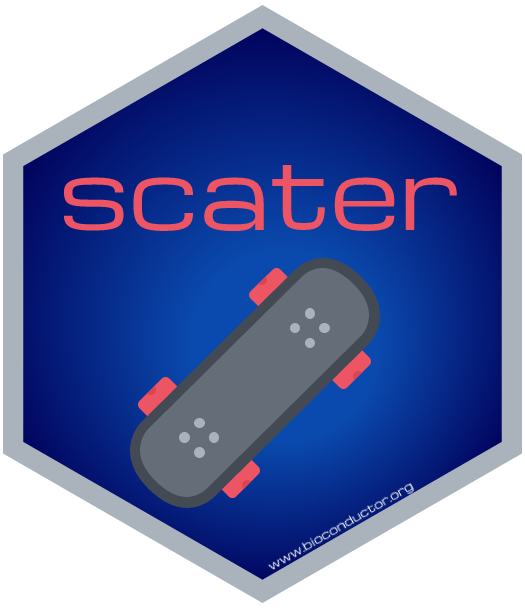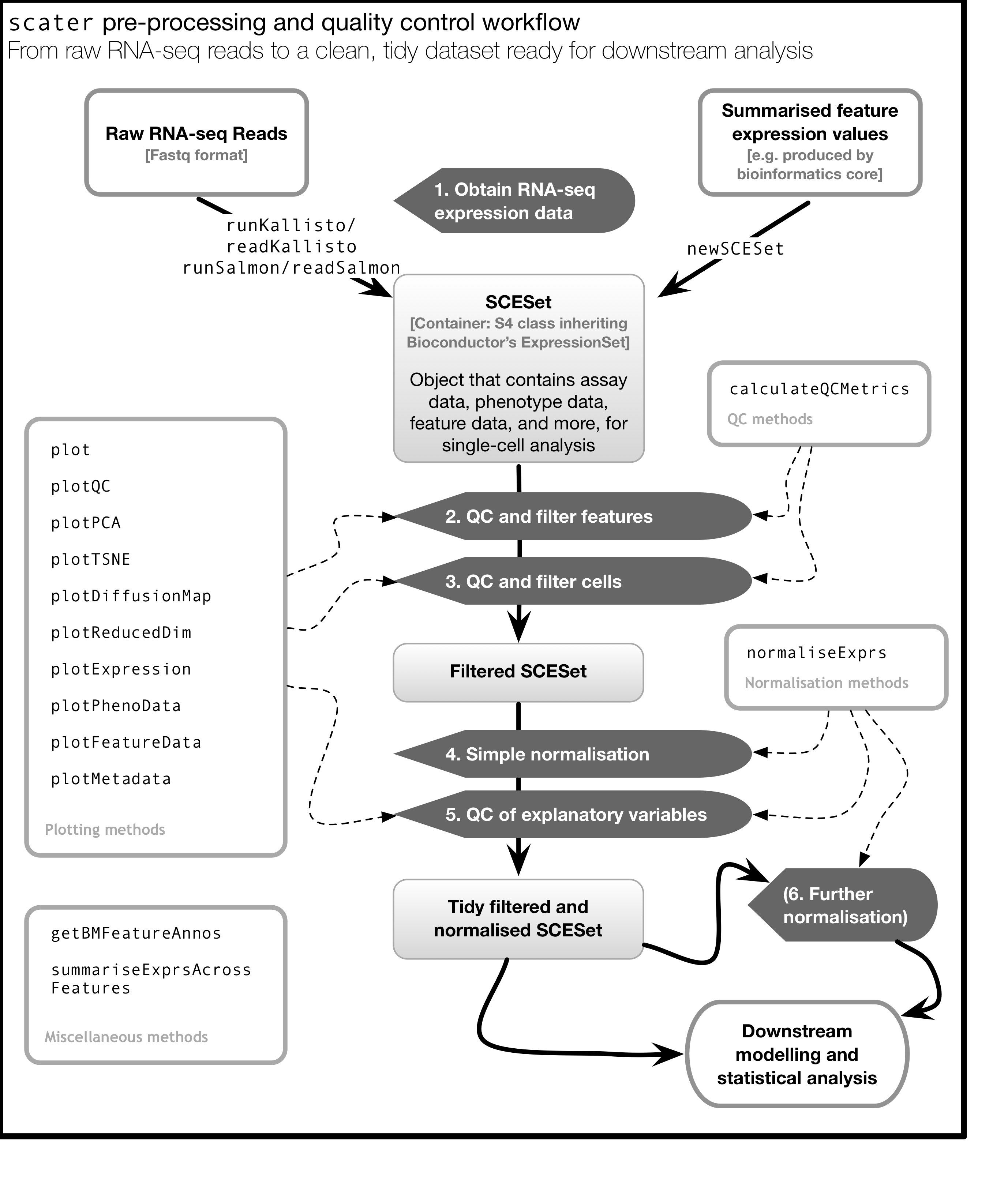This package contains useful tools for the analysis of single-cell gene expression data using the statistical software R. The package places an emphasis on tools for quality control, visualisation and pre-processing of data before further downstream analysis.
We hope that scater fills a useful niche between raw RNA-sequencing
count or transcripts-per-million data and more focused downstream
modelling tools such as
monocle,
scLVM,
SCDE,
edgeR,
limma
and so on.
Briefly, scater enables the following:
- Automated computation of QC metrics
- Transcript quantification from read data with pseudo-alignment
- Data format standardisation
- Rich visualisations for exploratory analysis
- Seamless integration into the Bioconductor universe
- Simple normalisation methods
See below for information about installation, getting started and highlights of the package.
The scater package has been accepted into Bioconductor!
Thus, the most reliable way to install the package is to use the usual
Bioconductor method:
## try http:// if https:// URLs are not supported
source("https://bioconductor.org/biocLite.R")
biocLite("scater")
The scater package has been available as a "release" version in
the Bioconductor since April 2016. The release version of scater works with the release version of R and Bioconductor, and development will continue in the devel version of the package on Bioconductor. Future releases will follow the regular
Bioconductor release cycle.
Alternatively, scater can be installed directly from GitHub as
described below. In this case, package that scater uses ("depends
on" in R parlance) may not be automatically installed, so you may
have to install the required packages as shown below.
I recommend using Hadley Wickham's devtools package to install
scater directly from GitHub. If you don't have devtools installed,
then install that from CRAN (as shown below) and then run the call to
install scater:
If you are using R version 3.3:
install.packages("devtools")
devtools::install_github("davismcc/scater", build_vignettes = TRUE)
If you are using R version 3.2.3:
devtools::install_github("davismcc/scater", ref = "release-R-3.2", build_vignettes = TRUE)
If you find that the above will not install on Linux systems, please
try with the option build_vignettes = FALSE. This is a known issue
that we are working to resolve.
Using the most recent version of R is strongly recommended (R 3.3.2 at the time of writing). Effort has been made to ensure the package works with R >3.0, but the package has not been tested with R <3.1.1.
There are several other packages from CRAN and Bioconductor that scater uses,
so you will need to have these packages installed as well. The CRAN packages
should install automatically when scater is installed, but you will need to
install the Bioconductor packages manually.
Not all of the following are strictly necessary, but they enhance the
functionality of scater and are good packages in their own right. The commands
below should help with package installations.
CRAN packages:
install.packages(c("data.table", "ggplot2", "knitr", "matrixStats", "MASS",
"plyr", "reshape2", "rjson", "testthat", "viridis"))
Bioconductor packages:
source("http://bioconductor.org/biocLite.R")
biocLite(c("Biobase", "biomaRt", "edgeR", "limma", "rhdf5"))
Optional packages that are not strictly required but enhance the functionality of scater:
install.packages(c("cowplot", "cluster", "mvoutlier", "parallel", "Rtsne"))
biocLite(c("destiny", "monocle"))
You might also like to install dplyr for convenient data manipulation:
install.packages("dplyr")
The best place to start is the vignette. From inside an R session, load scater
and then browse the vignettes:
library(scater)
browseVignettes("scater")
There is a detailed HTML document available that introduces the main features
and functionality of scater.
The diagram below provised an overview of the pre-processing and QC workflow possible in scater, listing the functions that can be used at various stages. A first place to start is with the newSCESet function, which will allow you to create a data object for use with scater.
The scater package allows you to do some neat things relatively quickly. Some highlights are shown below with example code and screenshots.
- Automated computation of QC metrics
- Transcript quantification from read data with pseudo-alignment approaches
- Data format standardisation
- Rich visualisations for QC and exploratory analysis
- Seamless integration into the Bioconductor universe
- Simple normalisation methods
For details of how to use these functions, please consult the vignette and package documentation. The plots shown use the example data included with the package (for which there is no interesting structure) and as shown require only one or two lines of code to generate.
Use the calculateQCMetrics function to compute many metrics useful for gene/transcript-level and cell-level QC. Metrics computed include number of genes expressed per cell, percentage of expression from control genes (e.g. ERCC spike-ins) and many more.
The runKallisto and runSalmon functions provides wrappers to the kallisto and 'Salmon' software for quantifying transcript abundance from FASTQ files using a "pseudo-alignment"" or "lightweight alignment" approaches. These new approaches are extremely fast while retaining accuracy. With readKallistoResults and readSalmonResults, transcript quantities can be read into a data object in R.
Default plot for an SCESet object gives cumulative expression for the
most-expressed features (genes or transcripts)
The plotTSNE function produces a t-distributed stochastic neighbour embedding
plot for the cells.
The plotPCA function produces a principal components analysis plot for the
cells.
The plotDiffusionMap function produces a diffusion map plot for the cells.
The plotExpression function plots the expression values for a selection of
features.
The plotQC function produces a variety of QC plots useful for diagnostics and
feature and cell filtering. It can be used to plot the most highly-expressed
genes (or features) in the data set or create density plots to assess the
relative importance of explanatory variables, as well as many other
visualisations useful for QC.
The plotPhenoData function plots two phenotype metadata variables (such as QC
metrics).
See also plotFeatureData to plot feature (gene) metadata variables, including QC metrics.
Plus many, many more possibilities. Please consult the vignette and documentation for details.
The package leans heavily on previously published work and packages, namely
edgeR and
limma. The
SCESet class is inspired by the CellDataSet class from monocle,
and SCESet objects in scater can be easily converted to and from monocle's
CellDataSet objects.
The scater sticker is licensed under Creative Commons Attribution
CC-BY. Feel free to
share and adapt, but don't forget to credit the author. Skateboard icon made by
Nikita Golubev from
Flaticon is licensed by Creative Commons BY 3.0.
We hope the scater package makes your life easier when analysing single-cell RNA_seq data. Please do try it and contact me with bug reports, feedback, feature
requests, questions and suggestions to improve the package.
Davis McCarthy, April 2017


